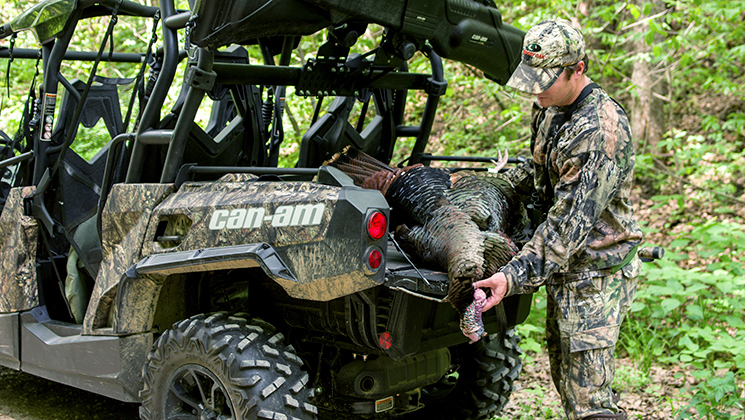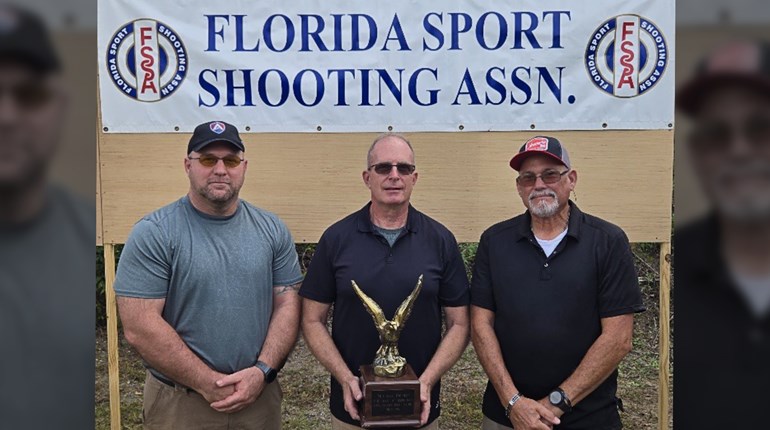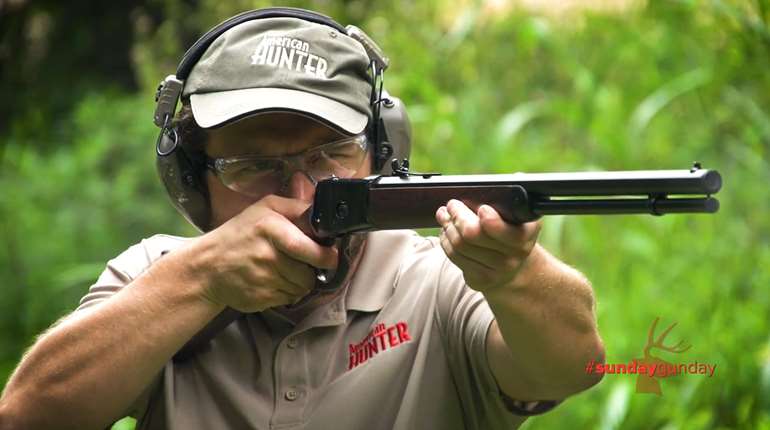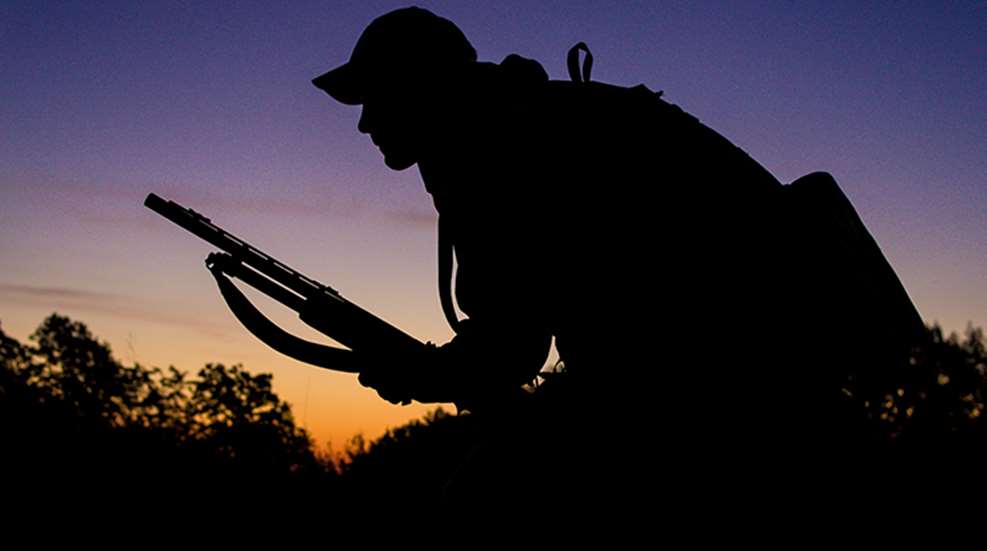
I’ve seen Rio Grande turkey hunters do much more running than gunning in hardwoods where stubborn Eastern gobblers just won’t put up with all their raucousness. Then again, few things are more maddening than a sit-and-cluck-all-day Eastern hunter who travels to Texas and won’t dare move on a Rio. I’ve witnessed both these hunters fail to employ tactics Westerners have used for years to stalk within gun range of a Merriam’s in Rocky Mountain country because these tactics are strange to them. It’s not the way they do it where they’re from.
Fact is, the world’s most successful turkey hunters adopt tactics best suited to the region, the subspecies of bird and even the individual gobbler. Last season I saw it all. From Florida to South Texas, South Dakota then northeast Kansas, I studied outstanding turkey hunters doing their thing in four distinctly different regions while hunting four of North America’s subspecies. In all four states, a different technique was utilized. While taking these birds in the same year could be classified as a “slam” of some sort I suppose, I don’t take much credit in merely pulling a trigger. But I did collect notes on some of the best turkey tactics going.
The Florida Stakeout-n-Fakeout
■ Objective: Osceola
■ Description: long legs, black wingtips; darkest turkey in color; about 20 pounds; very long spurs
■ M.O: gobbles sparingly; hardest to call in; at home in swamp
■ Location: Indiantown, Fla.
■ Terrain: flat, sandy grassland; palmetto thickets, palm trees and bayous; neighboring orange groves
■ Date: mid-March
■ Conditions: foggy, 75 degrees
■ Gun: Mossberg 500 Turkey 12-gauge
■ Ammo: Federal 3rd Degree 3" No. 6
■ Props: natural blind, Avian-X LCD decoys
It always happens. No matter if the property’s 2 or 20,000 acres the turkeys usually roost just on the other side of the fence. Florida’s Brady Ranch is a working cattle ranch and hunting operation that shares a border with private land that looks as though it was the inspiration behind the Tropicana orange juice label. You know the old “grass is greener” saying? Well this time the other side of the fence was orange … as in Florida’s juiciest oranges. Nothing indicated the birds were real keen on leaving their vitamin C sanctuary.
But I had a secret weapon. His name is Matt Morrett.
Morrett won his first turkey calling championship at age 8. The Pennsylvania prodigy then parlayed his talent into a job when he was hired on with Hunters Specialties, for whom he filmed turkey hunts all around the country. Thirty years later he still hunts turkeys professionally for Zink Calls. Bottom line, he’s accounted for the demise of almost as many gobblers as Thanksgiving. But what makes Morrett so deadly is not just his calling but his ability to read a turkey’s behavior and the terrain to adopt the best tactic to take the bird. Matt’s hunted around the country multiple times, so there are few situations he hasn’t seen.
So what’s a few strands of barbed wire and a lush orange grove when I’ve got Matt Morrett to pipe a gobbler into the teeth of my 12-gauge? I figured I'd sit and let the master call them in. Turns out Morrett has a few secret weapons himself.
“These birds haven’t been hunted yet,” Morrett explained as we drove the property the prior evening. “We’ll build a blind there, get their attention and wait for one to come to the decoys.” He pointed to a huge palmetto where the 101st Airborne could hide. To our back was the fence line; in front was a perfect meadow for strutting.
“Decoys?” I said, stressing the plural “s.” He said it as if we were about to go goose hunting.
“Oh yeah,” he said, as we put the finishing touches on our palmetto blind. “In some cases I’ll hit every aspect of a turkey’s psyche. I’ll set out a breeder hen—to appeal to a gobbler’s mating instinct—and a lookout hen—to show dominance to other hens and maybe bring them in too; the jake decoy will show a subdominant intrusion to incoming gobblers.” It all sounded legit—real Sigmund Freud stuff.
“Is this one of those cases?” I asked.
“Yes.”
The following morning, two minutes after legal shooting light, a 2-year-old gobbler tiptoed into the meadow to check out the parade, all the while gobbling his approval. Unable to withstand it, two more gobblers pitched down from the orange grove and strutted over with the sole purpose of assaulting Matt’s new Avian-X LCD decoy. I let the melee continue because I thought it was funny. Matt? Not so much, as new dekes are about $100 apiece, and I suspect Mr. Zink keeps track of how many Matt loses or destroys in a fiscal year.
Moments later, I placed the Mossberg’s bead on the tom’s beak and pulled the trigger. Fifteen minutes into my four-state turkey quest, the Osceola box was checked. World-champion caller Matt Morrett had called only once.
The Lesson: Decoys can be difference makers, especially in the early season, so don’t ever completely rule them out as some hunters do. Try multiple birds, and even a jake decoy where you know dominant toms to be. Sometimes a decoy is worth 1,000 yelps. I’ve used them all, and the Avian-X LCD (Lightweight Collapsible Decoy) is the all-around best on the market.
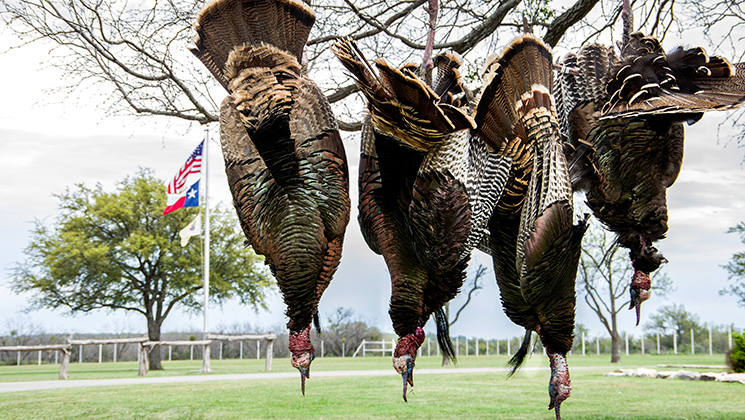
The Hobo Hunter Strikes
■ Objective: Rio Grande
■ Description: tan-colored band at top of tail feathers
■ M.O: runs in large flocks; very rangy; responds well to calling
■ Location: Sonora, Texas
■ Terrain: flat mesquite rangeland; cactus, meadows, windmills, feedlots
■ Date: early April
■ Conditions: windy, 80 degrees
■ Gun: Mossberg 500 Turkey 12-gauge
■ Ammo: Federal 3rd Degree 3" No. 6
■ Props: Can-Am ATV, Avian-X LCD decoys, camo blind material, lunch, seat cushion, water
Normally, hunting Rios on a private Texas ranch is relatively easy. Thanks to large populations and competition for hens, gobblers often sprint to calls. At least this is what I was telling Mossy Oak Chief Marketing Officer and my hunting partner Ben Maki as we drove toward his favorite spot on an exclusive hunting lease.
“Yeah,” I boasted, “If I can’t kill a couple birds here in a morning or two, well then, I might be a buffoon!”
Well I’ll be a buffoon.
Normally amid this cattle/whitetail rangeland it goes like this: You locate a flock of turkeys (look for the largest cottonwood tree near the only creek) and locate the windmill/feedlot. Then you position yourself just off a two-track road between the roost and the food. Then you call in a gobbler somewhere in between the two.
If somehow that doesn’t work, you walk the two-tracks and hack on a box call every few minutes to strike one up. When one responds you use the mesquite trees for cover to close the distance. When you get close, you hammer his ears with your raspiest cutt. If he doesn’t come in, usually another tom will. And if no toms come in, or you miss one or whatever, you get in the ATV, roll a few hundred yards down the two-track and try it again. This is where the run-and-gun was perfected, because it works. Normally.
Ben and I tried everything. He’d call. I’d call. We’d walk and call. We’d sit and call. He’d sit, I’d call. We glassed distant food plots and climbed windmills looking for birds. I even tried my lucky crow call. Then we’d walk and call again. Nothing.
In South Texas, hunting turkeys all day for five days without calling one in is an eternity. Finally, on the sixth and last morning, Ben thought long and hard. He’d been hunting the property for years, and he knew a few protected meadows where gobblers historically strutted.
“We’ll get there early, set up and wait until we kill a bird,” he proclaimed boldly, like only a chief officer can.
“OK,” I said. I’d long since learned never to guide the guide. That way if you don’t get anything, you can blame him.
We fashioned makeshift blinds at dawn, and burrowed in for the long haul. By early afternoon I’d finished breakfast, lunch, two writing assignments, written an exculpatory letter to my girlfriend, shaved and was currently amid a nice nap. Suddenly Ben hissed at me from a few cactuses away. I looked up and saw a big Rio skulking across the field. Hastily I rifled through my camera gear, computer, empty soda cans, clothing, phone charging station and backpack to uncover my shotgun. I raised it, pasted bead on the gobbler’s neck and sent a batch of 3rd Degree pellets screaming. The bird skulked no more.
Ben raced out to get my bird, grabbed it then walked it over to my blind to congratulate me. That’s when I saw his beaming smile melt into a look of utter disbelief as he surveyed the swarthy little habitation I’d created.
“You look like a … a …” he stuttered, “a hobo!”
“Well, maybe,” I said, gathering my things. “But there’s a Rio in my bindle!”
The Lesson: Read the gobblers. If they’re not responding to calls—or going away from them—find where they are going by scouting. When you figure out where they’re loafing, ambush them there. You can’t always run-and-gun.

The Fan and the Can-Do Man
■ Objective: Merriam’s
■ Description: white tail-feather tips, short beard and spurs; light gobbles; 30 lbs. max
■ M.O: visually oriented
■ Location: Rosebud Reservation, S.D.
■ Terrain: mountainous hills separated by wending creek draws; pine bluffs, grassland
■ Date: mid-April
■ Conditions: windy, 50 degrees
■ Gun: Mossberg 500 Turkey, 12-gauge
■ Ammo: Federal 3rd Degree 3" No. 6
■ Props: homemade tail fan, binocular, Can-Am ATV
I suppose everybody knows a guy who lives for turkey hunting. I certainly do. My guy doesn’t drink or have any vices I can tell—except turkey hunting. He loves it more than anything, except maybe his daughter. But she also turkey hunts and guides with him, so yes, I believe he loves turkey hunting more than anything. I’ve never seen someone so fired up to chase turkeys as Ken Byers. Ken’s only problem is, he can’t sit still to save his life. So spot-and-stalk Merriam’s hunting suits him fine.
Hunting turkeys with Ken is more like elk hunting for birds. When he sees a turkey, he generally either races down a draw or around a mountain, then pops over a hilltop and shoots it. Or, if there’s no cover, he unfurls a tail fan like an earth-toned matador and waves them in. Sometimes a dominant tom will come runnin’. Sometimes Ken runs toward them. It didn’t matter to me, so long as it culminated in a Merriam’s in the bed of the Can-Am. But after four days I was beginning to lose faith in this fanning business.
It was the last afternoon when we spotted a flock of birds from the road. They were clear across a rolling meadow. We could use the hills to get within 150 yards of them, but beyond that I felt it was hopeless. Fortunately for me, Ken’s a can-do man. I just tried to keep up.
Minutes later, I was out of breath, crawling on knees and elbows to the hill’s crest. Ken was already there. He motioned me to stop.
His twinkling, turkey-killin’ eyes said, “Watch this.” And so I did.
Ken unfurled his fan and flashed it in the sun while peeking smartly through a designed gap in its tail feathers. When he said “Get ready,” I thought he was kidding.
Moments later a racing, almost rabid-looking turkey appeared in front of my face from somewhere unseen. I raised my shotgun instinctively—defensively—and swung on him, dumping him on top of the hill, 5 yards before he sank his talons into Ken’s turkey fan and possibly into Ken. I considered myself somewhat of a hero. I rolled over on my back and thanked the heavens for granting me this fine Merriam’s.
Still prone, Ken took one look at the bird and said, “Oh man, what a great Rio!”
“A Rio?”
“Yep, we have them here, too. What a bird!”
Despite my turkey slam coming to an end, it was impossible to feel disappointed with another great Rio down—and Ken Byers acting as though we’d just won the lottery. I tell you, it helps to hunt with a can-do man. Indeed, I believe that’s why a turkey-hunting miracle ensued right then and there.
Just then a gust of wind hit the downed Rio, causing his tail fan to flap wildly.
Come to find out, the Merriam’s gobbler and his flock we spotted earlier had scattered at my gunshot, but were now regrouping several hundred yards away. That Rio’s fan enraged the boss bird.
“Get ready!” mimed Ken. I thought he was kidding.
Moments later, a giant Merriam's gobbler appeared out of nowhere, and I dumped him on the run at 5 yards, saving Ken again.
Both South Dakota tags now filled, I again rolled over on my back and let out a victory whoop.
“Ken,” I said.
“What?”
“Put away that tail fan.”
The Lesson: Always carry a tail fan, especially when hunting open country. Also, always keep a positive attitude. Anything can happen so long as you’re still in the field.
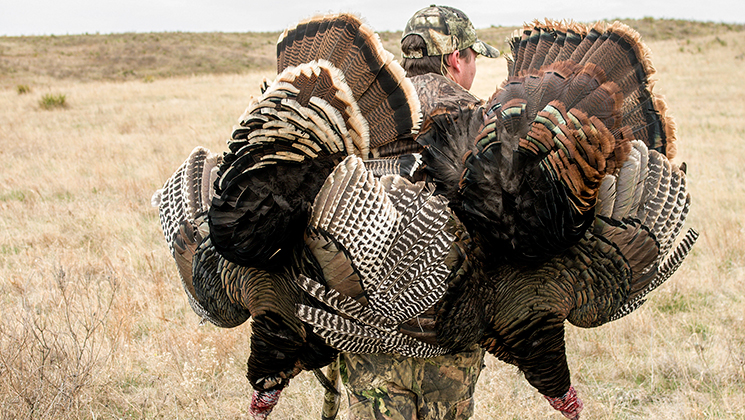
The Kansas Swing-and-Miss
■ Objective: Eastern
■ Description: brown-colored tail fan, long beard; over 30 lbs. max; heart-wrenching gobbles
■ M.O: prefers deep cover; very wary
■ Location: Northeast Kansas
■ Terrain: rolling oak hardwoods divided by cut cornfields; deep creek bottoms
■ Date: mid-May
■ Conditions: windy, 80 degrees
■ Gun: Mossberg 500 12-gauge
■ Ammo: Federal 3rd Degree 3.5" No. 6
■ Props: Avian-X LCD decoy
Kansas may seem like an odd place to go for Eastern turkeys, but that’s only because most people associate it with flat cornfields and pheasants—not the mountainous country on its eastern border that looks like the Ozarks. Nestled along the Missouri River, this area is known for its lush cropland, giant whitetails and monstrous Eastern turkeys. You know, the kind that raise your hat off your head when they unleash a thunderous KAAAAA! under an umbrella of oaks.
The downside is that my final bird, the dreaded Eastern, is in my opinion the hardest turkey to kill, mainly because he hangs in the hardwoods and is naturally very suspicious. I was telling my guide, Heath, all about how tough Eastern turkeys are when he locked up the brakes and pointed to the middle of a freshly cut cornfield, as flat and open as a soccer field.
“There’s a big one,” he deadpanned.
He wasn’t kidding. There, 400 yards before me, was one of the largest turkeys I’ve ever seen. I could see his thick beard easily with my naked eye.
Like a fire drill we dove into the bar ditch and surveyed the situation. Heath also had attended tail-fanning school, and so he broke it out. He gave some loud cutts to get the giant’s attention, and the ruse worked. The behemoth began walking toward us. My Eastern turkey was in the bag … until I missed.
Folks, when I miss, I miss big. I am embarrassed to say that I missed a large turkey with a large-gauge shotgun. I’m not sure how, but I’m sure I did. And it gets worse. As the turkey flew off, I missed twice more. But I saw where he landed and ran into the woods and so I chased him. Finally, I flushed him and I missed him several more times. I never did find that turkey.
Dinner in camp that night was a never-ending affair fraught with insults and ribbings piled much higher than the mashed potatoes.
After a few days of hard hunting, we finally heard a gobble late one morning, and the chess match began. We’d call, and it would move. We’d call and it would get a little closer, so we’d get ready, and then it would move away. This kept up for an hour. Finally, Heath motioned for me to ease down a steep little finger ridge toward the bird. He stayed back to call.
I crawled into position 50 yards ahead and finally saw movement. The bird paced back and forth, up and down that ridge in an attempt to call us to him. Typical of an old Eastern, he wouldn’t budge. Heath would call, he would fire back. But he wouldn’t commit. I shifted angles and finally spotted his red-and-white head through the trees, 45 yards out.
“Boom!” wailed the Mossberg.
“Did you miss again?” yelled Heath.
“Yes,” I replied. But I was kidding. My mission was complete. My turkey education, however, is to be continued.
The Lesson: Know the land to make subtle moves on a gobbling bird. Try the buddy calling system for hung-up gobblers: Send one guy ahead silently, while a partner calls from farther back.
